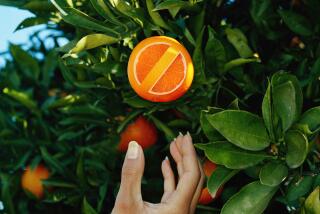How to Pick the Best Summer Fruit : Learn to Spot Good Quality by Look, Smell and Feel
- Share via
It is sometimes difficult to judge quality of fruits in markets. Experience is a wonderful teacher, but here are a few tips from the U.S. Department of Agriculture to help accelerate the process of handling and judging seasonal fruits.
--Pick the fruit yourself. Experience is the only way you can learn how to tell good fruit from bad, ripe from non-ripe.
--Don’t buy just because of low price. “It seldom pays to buy perishable fruits merely because the price is low,” the agency states. “Unless the lower price is a result of overabundance of the fruit at the time, the so-called bargain may be undesirable.”
--Buying more fruit than you need may result in unnecessary waste, even if the product is cheaper in quantity.
--Some products decline rapidly in quality if improperly displayed or displayed for a length of time without refrigeration. This can and does happen even under the most modern handling methods.
Look for More Than Size
--Don’t buy according to size alone. Large fruits are not necessarily the best quality, nor are they always economical. Appearance is not everything.
--Always buy in season. Quality is usually higher and prices more reasonable when you buy fruit in season. Out-of-season produce is generally more expensive.
--Foods that are in greatest supply, such as those during the summer months, are usually best choices at the most reasonable prices.
--Don’t pinch. Rough handling during selection can cause bruises, spoilage and unnecessary waste. Such losses to the grocer are usually passed on to the customer.
Ripen Fruits in Bag
--Fresh peaches, nectarines, pears, plums and apricots are hand-picked at maturity, yet they are firm enough for packing and shipping. When these fruits ripen, they release a clear and odorless gas called ethylene that promotes the ripening process. To trap the ethylene, place the fruit in a loosely closed paper bag or ripening bowl for several days or leave at room temperature for a day or two until fragrant and ripe. Refrigeration will slow the ripening process. These fruits are most flavorful at room temperature.
--Should you want to freeze peaches, plums, nectarines or apricots for use during later months, cut into wedges or slices. Stir one quart water with one to 1 1/2 tablespoons commercial ascorbic acid mixture. Mix with fruit gently but thoroughly. Pack fruit (still in ascorbic acid mixture) in plastic freezer bags. Freeze in single layer until frozen, then stack.
Here are some tips on selecting summer fruit:
Apricots--Most fresh apricots are marketed in June and July. Look for apricots that are plump and juicy with uniform, golden-orange color. A ripe apricot yields to gentle pressure on the skin.
Cherries--The sweetest cherries are found in Western states and are available from May through August. Good cherries have bright, glossy, plump surfaces and fresh-looking stems. Bing, Black Tartarian, Schmidt, Chapman and Republican varieties should range from deep maroon or mahogany red to black. Lambert cherries should be dark red. Over-mature cherries lack flavor and appear shriveled with dried stems. Avoid those.
Grapes--Most European-type grapes are grown in California. Always look for well-colored, plump grapes firmly attached to the stems. Bunches are more likely to hold together if the stems are predominantly green and pliable. White or green grapes are sweetest when the color has a yellow cast tinged with amber. Red varieties are best when red predominates. Avoid leaking, shriveled or wrinkled grapes.
Melons--Cantaloupes generally are available from May through September. Selecting melons for quality is not easy even for the most experienced buyer. For cantaloupes, however, look for three major signs of full maturity: The stem should be gone, leaving a smooth, symmetrical, shallow basin called a “full slip”; the netting or veining should be thick, coarse and corky and stand out in bold relief, and the skin color between the netting should have changed from green to a yellowish buff, yellowish gray or pale yellow color.
Although most melons are ripe when they reach the marketplace, their best eating stage may not have been reached. Hold them for a day or two at room temperature to allow completion of ripening.
Avoid overripe fruit with a pronounced yellow rind color. Large bruise areas should be avoided. Small bruises normally are harmless.
--Honeydew: The very smooth firm rind varies from creamy white to creamy yellow, depending on stage of ripeness. The stem does not separate from the fruit and must be cut for harvesting, so the stem test done for cantaloupe does not apply. A mature honeydew is apparent by a soft, velvety feel and a faint, pleasant fruit aroma. The skin should be a yellowish white to cream rind color. Avoid melons with a dead white or greenish-white color and a hard-smooth feel, the signs of immaturity.
--Persian: Grown in California, they are available in good supply in August and September when in season. Persian melons resemble cantaloupes, but are more nearly round and have a finer netting. When selecting Persian melon, the same factors of quality and ripeness listed for cantaloupes apply.
--Watermelons: Judging quality and ripeness of watermelon is also difficult, unless it is cut in half or quartered. If you want to buy an uncut watermelon, here are a few tips that may be helpful, although not totally reliable: The watermelon surface should be relatively smooth, the rind should have a slight dullness (neither shiny nor dull), and the ends of the melon should be filled out and rounded. The underside or belly of the melon should have a creamy color.
With cut melons, look for a firm, juicy flesh with rich red color, free from white streaks. Seeds should be dark brown or black. Avoid melons with pale-colored flesh and white streaks or white heart and whitish seeds, signs of immaturity. Dry, mealy flesh or watery, stringy flesh is a sign of over-maturity or aging after harvest.
Nectarines--Nectarines combine characteristics of the peach and the plum. Look for rich color and plumpness with a slight softening along the seam of the nectarine. Most varieties have an orange-yellow color between red areas. Some varieties have a greenish ground color. Brightness is a sign of maturity. Firm or moderately hard fruit will normally ripen within two or three days at room temperature.
Avoid hard, dull fruits or slightly shriveled fruits, which may have been picked too soon and are of poor eating quality. Avoid soft or overripe fruits or those with cracked or punctured skin, which are signs of decay.
Peaches--There are two general types of peaches: freestone and clingstone. Freestones are usually preferred for eating fresh or for freezing; white clingstones (flesh clings tightly to the pit) are used primarily for canning, although some are sold fresh.
Look for peaches that are fairly firm or on the verge of softness. The skin color between the red areas should be yellow or creamy. Avoid very firm or hard peaches with a distinctly green ground color, since these are probably immature and will not ripen properly. Also avoid very soft fruits, which are overripe. Don’t buy peaches with large flattened bruises or peaches with any sign of decay.
Plums or prunes--Varieties differ widely in appearance and flavor, so you should buy and taste one to see if that is the variety that appeals to you. Look for plums and prunes with a good color in a fairly firm to slightly soft stage of ripeness. Avoid fruits with skin breaks, punctures or brownish discoloration. Also avoid relatively hard, poorly colored or very tart fruit (signs of immaturity).
More to Read
Eat your way across L.A.
Get our weekly Tasting Notes newsletter for reviews, news and more.
You may occasionally receive promotional content from the Los Angeles Times.










